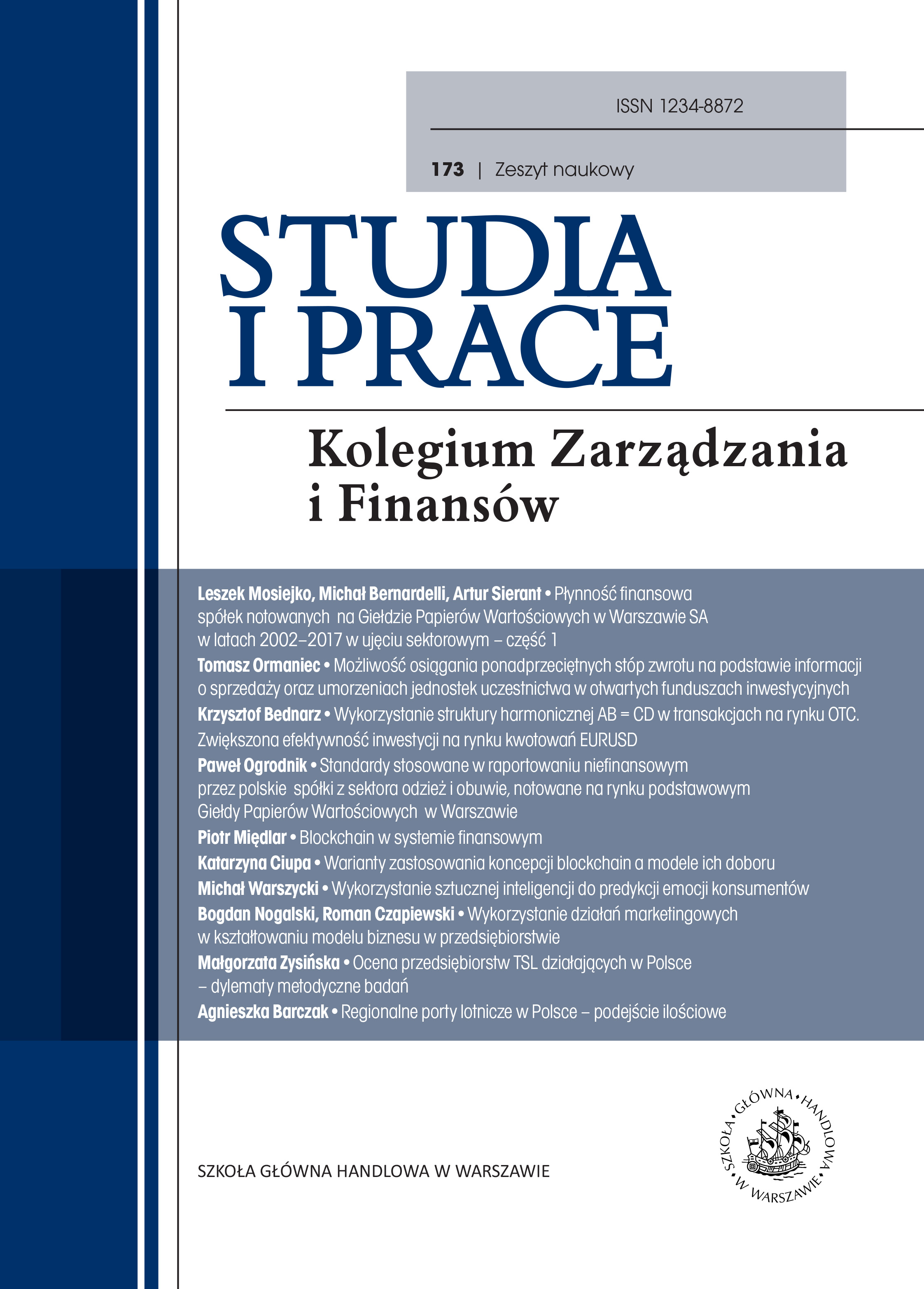Achieving Above Average Rates of Return Based on Information about Sold and Redeemed Shares of Open-End Funds
DOI:
https://doi.org/10.33119/SIP.2019.173.2Keywords:
market efficiency, investment strategies, finance management, personal finance, investment fundsAbstract
The paper aims at proposing a dynamic investment strategy based on information about sold and redeemed shares of open-end funds, which offers above-average rates of return to investors. The first part of the paper formulates a hypothesis of an efficient market, according to which the strategy in question should be inefficient. It also discusses ways to assess the quality of portfolio management. The second part of the paper presents results of the study which consisted in creating dynamic investment portfolios, to which monthly adjustments were made based on the author’s assumptions. Then the performance of static and dynamic (variable asset allocation) portfolios was compared.
Downloads
References
2. Barber B. M., Odean T. [2001], Boys Will be Boys: Gender, Overconfidence, and Common Stock Investment, „The Quarterly Journal of Economics”, t. 116, s. 261–292.
3. Barber B. M., Odean T. [2007], All that Glitters: The Effect of Attention and News on the Buying Behavior of Individual and Institutional Investors, „The Review of Financial Studies”, t. 21,
nr 2, s. 785–818.
4. Barberis N., Shleifer A., Vishny R. [1998], A Model of Investor Sentiment, „Journal of Financial Economics”, t. 49, nr 3, s. 307–343.
5. Basu S. [1977], Investment Performance of Common Stocks in Relation to Their Price-Earnings Ratios: A Test of the Efficient Market Hypothesis, „The Journal of Finance”, t. 32, nr 3, s. 663–682.
6. Chen G., Kim K. A., Nofsinger J. R., Rui O. M. [2007], Trading Performance, Disposition Effect, Overconfidence, Representativeness Bias and Experience of Emerging Market Investors, „Journal of Behavioral Decision Making”, t. 20, nr 4, s. 425–451.
7. Fama E. [1970], Capital Markets: A Review of Theory and Empirical Work, „The Journal of Finance”, t. 25, nr 2, s. 383–417.
8. Gregoriou G. N., Gueyie J. P. [2003], Risk-Adjusted Performance of Funds of Hedge Funds Using a Modified Sharpe Ratio, „The Journal of Wealth Management”, t. 6, nr 3, s. 77–83.
9. Grinblatt M., Keloharju M. [2009], Sensation Seeking, Overconfidence, and Trading Activity, „The Journal of Finance”, t. 64, nr 2, s. 549–578.
10. Haugen R. A. [1996], Teoria nowoczesnego inwestowania: obszerny podręcznik analizy portfelowej, WIG-Press, Warszawa.
11. Jegadeesh N., Titman S. [2001], Profitability of Momentum Strategies: An Evaluation of Alternative Explanations, „Journal of Finance”, t. 56, nr 2, s. 699–720.
12. Jensen M. C. [1968], The Performance of Mutual Funds in the Period 1945–1964, „Journal of Finance”, t. 23, nr 2, s. 389–416.
13. Keim D. B. [1983], Size-Related Anomalies and Stock Return Seasonality, „Journal of Financial Economics”, t. 12, nr 1, s. 13–32.
14. Kolbadi P., Ahmadinia H. [2011], Examing Sharp, Sortino and Sterling Ratios in Portfolio Management, Evidence from Tehran Stock Exchange, „International Journal of Business and
Management”, t. 6, nr 4, s. 223–236.
15. O’Neal E. [2001], Window Dressing and Equity Mutual Funds, Babcock Graduate School of Management Working Paper.
16. Scharfstein D. S., Stein J. C. [1990], Herd Behavior and Investment, „The American Economic Review”, t. 80, nr 3, s. 465–479.
17. Sharpe W. F. [1966], Mutual Fund Performance, „Journal of Business”, t. 39, nr 1, s. 119–138.
18. Sharpe W. F. [1994], The Sharpe Ratio, „Journal of Portfolio Management”, t. 21, nr 1, s. 49–58.
19. Smirlock M., Starks L. [1986], Day-of-the-week and Intraday Effects in Stock Returns, „Journal of Financial Economics”, t. 17, nr 1, s. 197–210.
20. Sortino F. A., Price L. N. [1994], Performance Measurement in a Downside Risk Framework, „The Journal of Investing”, t. 3, nr 3, s. 59–64.
21. Thaler R. H. [1987], The January Effect, „The Journal of Economic Perspectives”, t. 1, nr 1, s. 197–201.
22. Treynor J. L. [1965], How to Rate Management of Investment Funds, „Harvard Business Review”, t. 43, nr 1, s. 63–75.
Materiały internetowe
1. Idea TFI zawiesza odkupywanie jednostek uczestnictwa [2012], „Dziennik Gazeta Prawna”, serwisy.gazetaprawna.pl/finanse-osobiste/artykuly/633130, idea_tfi_zawiesza_odkupywanie_
jednostek_uczestnictwa_funduszu.html [dostęp 12.03.2019].
2. Izba Zarządzających Funduszami i Aktywami [2019], www.izfa.pl/dane-statystyczne [dostęp 28.02.2019].
3. Komisja Nadzoru Finansowego [2016], Ochrona praw nieprofesjonalnych uczestników rynku walutowego (Forex, kantorów internetowych i rynku walut wirtualnych) – Informacja o wynikach kontroli, www.nik.gov.pl/plik/id,12996, vp,15405.pdf [dostęp 28.02.2019].
4. Morbiato J. [2014], Copernicus Dłużnych Papierów Korporacyjnych przestanie istnieć, „Dziennik Parkiet”, 3 września, www.parkiet.com/artykul/1387914.html [dostęp 12.03.2019].
5. Morbiato J. [2015], Inventum TFI: Inwestorzy chcieli wycofać 55 mln zł. Nie zdążyli, „Dziennik Parkiet”, 8 lipca, www.parkiet.com/artykul/1432807.html [dostęp 12.03.2019].
6. Pekao Towarzystwo Funduszy Inwestycyjnych S. A. [2019a], pekaotfi.pl/files/DOKUMENTY/KII/KII_PekaoTFI_3AGGR.pdf [dostęp 11.03.2019].
7. Pekao Towarzystwo Funduszy Inwestycyjnych S. A. [2019b], www.pekaotfi.pl/files/DOKUMENTY/KII/KII_PekaoTFI_7MONEY.pdf [dostęp 11.03.2019].
8. Powszechny Zakład Ubezpieczeń [2019], www.pzu.pl/_fileserver/item/1512119 [dostęp 11.03.2019].
9. Quercus Towarzystwo Funduszy Inwestycyjnych S. A. [2019], quercustfi.pl/sites/default/files/pliki/DOCUMENTS/KII/quercus_ochrony_kapitalu_kiid.pdf [dostęp 11.03.2019].
10. Santander Towarzystwo Funduszy Inwestycyjnych S. A. [2019a], santandertfi.pl/asset/k/a/r/karta_santander_strategia_akcyjna_89847.pdf [dostęp 11.03.2019].
11. Santander Towarzystwo Funduszy Inwestycyjnych S. A. [2019b], santandertfi.pl/asset/k/i/i/ki-id_santander_zrownowazony_88759.pdf [dostęp 11.03.2019].
12. Santander Towarzystwo Funduszy Inwestycyjnych S. A. [2019c], santandertfi.pl/asset/k/i/i/ki-id_santander_stabilnego_wzrostu_88758.pdf [dostęp 11.03.2019].
13. Santander Towarzystwo Funduszy Inwestycyjnych S. A. [2019d], santandertfi.pl/asset/k/i/i/ki-id_santander_obligacji_skarbowych_88754.pdf [dostęp 11.03.2019].
14. Towarzystwo Funduszy Inwestycyjnych PZU S. A. [2019a], www.pzu.pl/_fileserver/item/151–2106 [dostęp 11.03.2019].
15. Towarzystwo Funduszy Inwestycyjnych PZU S. A. [2019b], www.pzu.pl/_fileserver/item/151–2076 [dostęp 11.03.2019].









